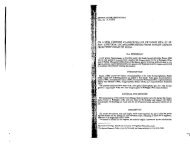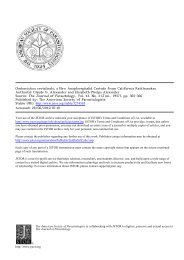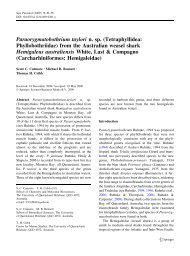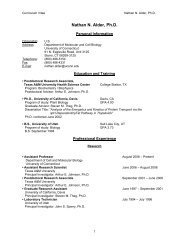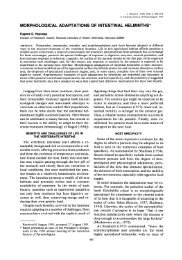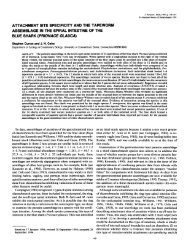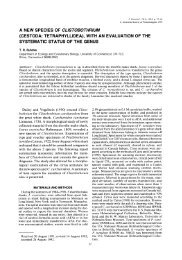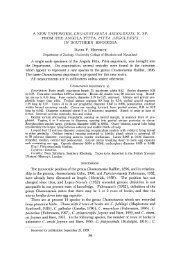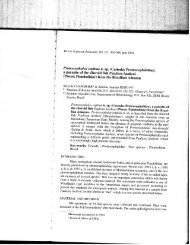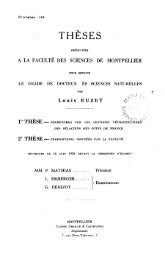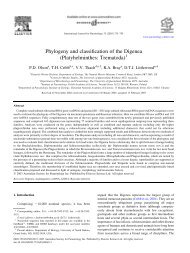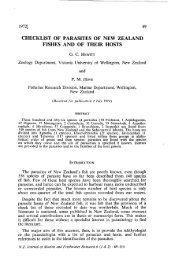The terminology of larval cestodes or metacestodes
The terminology of larval cestodes or metacestodes
The terminology of larval cestodes or metacestodes
You also want an ePaper? Increase the reach of your titles
YUMPU automatically turns print PDFs into web optimized ePapers that Google loves.
13broad and elongate cercomer in coleopteran hosts(Voge & Heyneman, 1957; Schiller, 1959; Voge,1961; Joyeux & Baer, 1961). In addition, bothH. citelli and Microsomacanthus ductilis have cercomersjust slightly sh<strong>or</strong>ter than the soma (Voge,1961; Burt & Jarecka, 1984), indicating that therelative size <strong>of</strong> the cercomer may be difficult toevaluate in certain cases. <strong>The</strong> intention <strong>of</strong> thedefinition proposed by Skrjabin & Mathevossian(1942) to distinguish cysticercoids with a greatlyreduced cercomer is readily applicable to those <strong>of</strong>the davaineid genera Raillietina (seeWetzel, 1934;Voge, 1960; Bartel, 1965) and Davainea (see Wetzel,1932; Abdou, 1958). <strong>The</strong> criterion does notapply to all davaineids as Ophryocotyle has anelongate cercomer (Burt, 1962). <strong>The</strong>ref<strong>or</strong>e, the definition<strong>of</strong> a microcercus is potentially useful, buthas been misapplied in the literature.3. Diplocyst (Figure 3C)<strong>The</strong> diplocyst was defined initially by Skrjabin& Mathevossian (1942) as a cysticercoid with nocercomer <strong>or</strong> ‘caudal annex’ in which there aretwo separate retractions into the soma. <strong>The</strong> descriptionwas based on a cysticercoid describedby Mrázek (1906) from earthw<strong>or</strong>ms. Skrjabin& Mathevossian (1942) nominated Aploparaksiscrassirostris as a representative <strong>of</strong> this type <strong>of</strong>cysticercoid.Most species exhibiting the development <strong>of</strong> adiplocyst belong to Aploparaksis, a hymenolepididgenus parasitic mainly in charadriif<strong>or</strong>m birdsand the diplocyst is found in oligochaets. Bondarenko& Kontrimavichus (1976a,b) consideredthat five species <strong>of</strong> Aploparaksis (A. bulbocirrus,A. groenlandica, A. furcigera, A. polystictae andA. taimyrensis) exhibited this type <strong>of</strong> development(see also Demshin, 1976; Gulyaev, 1977)to which can be added A. australis (see Bondarenko,1989), A. clangulae (see Bondarenko &Kondratyeva, 1985), A. filum (see Demshin, 1981;Bondarenko, 1990), A. kulachkovae (see Bondarenko,1987), A. pseud<strong>of</strong>ilum (see Bondarenko,1990) and A. sanjuanensis (see Demshin, 1985).Bondarenko & Kontrimavichus (1976) describedfour variants <strong>of</strong> the typical diplocyst. A ‘caudatediplocyst’ was considered to be present inA. brachyphallos and A. crassirostris (see Bondarenko& Kontrimavichus, 1976a; Demshin,1984), while a variant, the fl<strong>or</strong>icyst, in which thecysticercoid was partially embedded in the cercomer,resembling a closed flower, was present inA. birulai (see Bondarenko & Krasnoschchekov,1978). <strong>The</strong> ramicercus (Figure 3D), in which thecercomer has 6-10 digitate appendages, was firstnamed by Skrjabin & Mathevossian (1942), basedon a cysticercoid described from Lumbriculus byMrázek (1907). Bondarenko & Kontrimavichus(1976b) identified a ramicercus in A. <strong>or</strong>ientalis andA. secessivus as well as in Wardium chaunense,while Demshin (1971) identified a similar caudatelarva in A. dujardini. Finally, a <strong>larval</strong> f<strong>or</strong>m wasfound in A. xemae in which multiple cysticercoidsbud from the cercomer, becoming detached at anearly stage <strong>of</strong> development (Bondarenko & Kontrimavichus,1976b); this <strong>larval</strong> stage was termedan autotomicrocercus and was compared with thestaphylocyst and urocyst (vide infra). A comparable<strong>larval</strong> f<strong>or</strong>m was also described in Wardiumfreyei by Bondarenko (1977).Gulyaev (1989) coined the term ascocercus f<strong>or</strong>the <strong>larval</strong> stage <strong>of</strong> amabiliids. However, the larvaappears to be identical with a diplocyst exceptthat the scolex may only be partly retracted, <strong>or</strong>there may be some indication <strong>of</strong> segmentation. <strong>The</strong>term ascocercus alludes to the elongate stalked cystwithin which the larva develops. However, ascocercusis simply a min<strong>or</strong> variant <strong>of</strong> the diplocyst.4. Monocercus (Figure 3E)<strong>The</strong> term ‘monocercus’ was <strong>or</strong>iginally erected byVillot (1882) f<strong>or</strong> Cysticercus arionis found ina mollusc by von Siebold (1850), characterisedby numerous globular structures around the cysticercoid.Mrázek (1907) indicated that during itsdevelopment the cercomer fragmented into globuleswhich persisted within the <strong>larval</strong> cestode.Gabrion et al. (1976), Gabrion (1981) and Gabrion& MacDonald (1980) studied the development <strong>of</strong>similar <strong>larval</strong> <strong>cestodes</strong> <strong>of</strong> Anomotaenia constricta,A. brevis, Paricterotaenia p<strong>or</strong>osa and Eurycestusavocati, all <strong>of</strong> which exhibited a similar f<strong>or</strong>m <strong>of</strong>development and defined a monocercus as being amonocephalic cysticercoid in which a primary lacunais present, the scolex develops externally andretracts, following which the cercomer detachesand fragments. <strong>The</strong>y considered that this type <strong>of</strong><strong>larval</strong> development was restricted to the Dilepididaeand, in a review <strong>of</strong> the literature, showedthat a similar mode <strong>of</strong> <strong>larval</strong> development occurredadditionally in the genera Amoebotaenia(see Joyeux & Baer, 1936), Trichocephaloides (see



